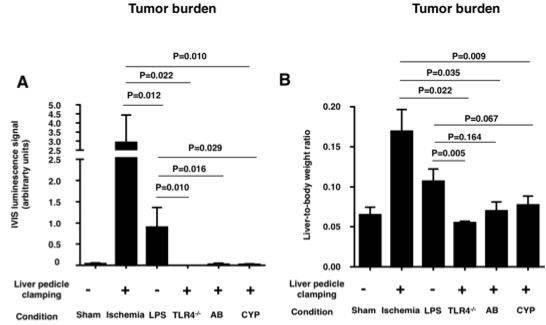Effects of the Gut-Liver Axis on Ischemia-Mediated Hepatocellular Carcinoma Recurrence in the Mouse Liver.
1Hepato-pancreato-biliary Centre, Department of Surgery, Geneva University Hospitals and Faculty of Medicine, Geneva, Switzerland
2Dipartimento di Biotecnologie e Scienze della Vita, Università
degli Studi dell'Insubria, Varese, Italy
3Division of Clinical Pathology, Department of Pathology and Immunology, Geneva University Hospitals and Faculty of Medicine, Geneva, Switzerland
Meeting: 2017 American Transplant Congress
Abstract number: B117
Keywords: Hepatocellular carcinoma, Ischemia, Liver, Recurrence
Session Information
Session Name: Poster Session B: Ischemic Injury and Organ Preservation Session II
Session Type: Poster Session
Date: Sunday, April 30, 2017
Session Time: 6:00pm-7:00pm
 Presentation Time: 6:00pm-7:00pm
Presentation Time: 6:00pm-7:00pm
Location: Hall D1
Background: There is growing evidence that liver graft ischemia-reperfusion (I/R) is a risk factor for hepatocellular carcinoma (HCC) recurrence after liver transplantation, but the involved mechanisms are unclear. Here, we tested the hypothesis that mesenteric congestion due to portal blood flow interruption induces endotoxin-mediated Toll-Like Receptor 4 (TLR4) engagement, resulting in elevated liver cancer burden. We also assessed the role of remote ischemic preconditioning (RIPC) in this context.
Methods: C57Bl/6j mice were exposed to standardized models of liver I/R injury and RIPC, by occluding hepatic and femoral blood vessels. HCC was induced by injecting RIL-175 cells in the portal vein. We further evaluated the impact of the gut-liver axis (LPS-TLR4 pathway) in this context, by studying mice with enhanced (LPS infusion) or defective (TLR4-/- knockout mice, gut sterilization, TLR4 antagonist) TLR4 responses.
Results: Portal triad clamping provokes upstream mesenteric venous engorgement, increased bacterial translocation, resulting in aggravated tumor burden. RIPC prevented this mechanism by preserving intestinal integrity and reducing bacterial translocation, thereby mitigating HCC recurrence. These observations are linked to the LPS-TLR4 pathway, as testified by the high and low tumor burden displayed by mice with enhanced, or defective, TLR4 response, respectively. Conclusion: Modulation of the gut-liver axis and of the LPS-TLR4 response by RIPC, gut-sterilization and TLR4 antagonism represent potential therapeutic targets to prevent ischemia-reperfusion lesions, and to alleviate HCC recurrence after liver transplantation.
Conclusion: Modulation of the gut-liver axis and of the LPS-TLR4 response by RIPC, gut-sterilization and TLR4 antagonism represent potential therapeutic targets to prevent ischemia-reperfusion lesions, and to alleviate HCC recurrence after liver transplantation.
CITATION INFORMATION: Orci L, Lacotte S, Delaune V, Oldani G, Slits F, Rossetti C, Rubbia-Brandt L, Morel P, Toso C. Effects of the Gut-Liver Axis on Ischemia-Mediated Hepatocellular Carcinoma Recurrence in the Mouse Liver. Am J Transplant. 2017;17 (suppl 3).
To cite this abstract in AMA style:
Orci L, Lacotte S, Delaune V, Oldani G, Slits F, Rossetti C, Rubbia-Brandt L, Morel P, Toso C. Effects of the Gut-Liver Axis on Ischemia-Mediated Hepatocellular Carcinoma Recurrence in the Mouse Liver. [abstract]. Am J Transplant. 2017; 17 (suppl 3). https://atcmeetingabstracts.com/abstract/effects-of-the-gut-liver-axis-on-ischemia-mediated-hepatocellular-carcinoma-recurrence-in-the-mouse-liver/. Accessed December 19, 2025.« Back to 2017 American Transplant Congress
